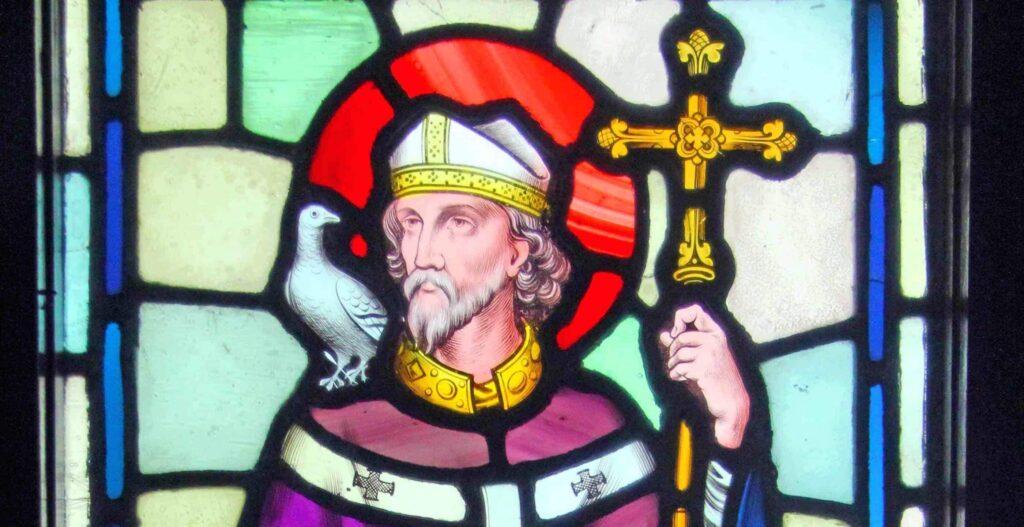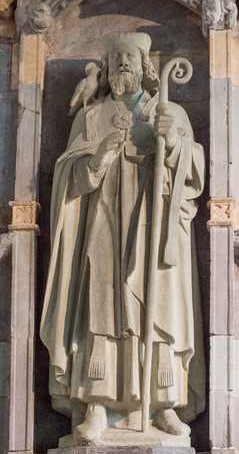Saint David

SAINT DAVID (or Dewi Sant in Welsh) was born on the south-west coast of Wales, near the present-day city that bears his name, St Davids, Pembrokeshire. The exact year of his birth is unknown, with estimates ranging from 462 to 515 AD.
Much of what we know about David comes from Rhygyfarch, the 11th-Century author who wrote the Life of Saint David. As it was written so long after the fact, its reliability is questionable. Additionally, the legend is woven with embellishments, which would have been undoubtedly inspiring to believers in centuries past.
We know that David was born into an aristocratic family. According to the legend, an angel foretold the birth of David to St Patrick 30 years before it happened.
Rhygyfarch wrote that he was the son of ‘sanctus rex ceredigionis’. This is believed to be Sandde or Sant, prince of Powys and the son of King Ceredig, the founder of Ceredigion.
David was born to St Non at what is now Capel Non’s, to the south of the city that bears his name. It is thought that Non was a victim of violation by Sandde after she resisted his initial advances. Non became a nun and was later canonised.
His mother is said to have given birth on a cliff top in the middle of a violent storm. The birthing process was said to have been so intense and fraught that her fingers left marks as she grasped the rock. As David was born, a bolt of lightning from heaven is said to have struck the rock, splitting it in two.

Non named her son Dewidd, though local Dyfed pronunciation meant he was commonly called Dewi. David is an Anglicised variation of the name derived from the Latin Davidus.
Brought up by his mother in Henfeynyw near Aberaeron, David is said to have been baptised at nearby Porthclais by St Elvis of Munster. It is said that a blind monk, Movi, was cured after drops of water splashed into his eyes as he held David.
David was educated at a monastery, usually taken to be Whitland in Carmarthenshire, under St Paulinus of Wales. He is said to have cured his tutor of blindness by making the sign of the cross. Realising that David was blessed, Paulinus sent him off as a missionary to convert the pagan people of Britain.
His best-known miracle is said to have taken place when he was preaching in the middle of a large crowd at the Synod of Brefi.
The village of Llanddewi Brefi stands on the spot where the ground on which he stood is reputed to have risen up to form a small hill.
A white dove, which became his emblem, was seen settling on his shoulder.
Saint David died on March 1, 589 AD and his remains were buried in a shrine in St David’s cathedral. St David’s Day falls on the first day of March each year – the day when Welsh people celebrate their patron saint.
On St David’s Day, many people in Wales pin a daffodil or leek to their clothes. The traditional meal is a soup made of lamb, leeks and other vegetables, known as cawl.
The tradition of eating and wearing leeks on St David’s Day supposedly dates back to the 6th Century.
Numerous festivals and dances – all with a dragon-theme – take place across Wales on March 1. Images of red dragons are used to celebrate because the dragon features on the Welsh national flag and is often considered a symbol of the country.

Children in Wales take part in school concerts or eisteddfodau, with recitation and singing being the main activities.
The flag of Saint David often plays a central role in the celebrations and can be seen flying throughout Wales.
Unlike St Patrick’s Day in Ireland, St David’s Day is not a national holiday, though there is strong support for it becoming a bank holiday in Wales.
EVENT: ST DAVID’S DAY
BACK TO HOME PAGE